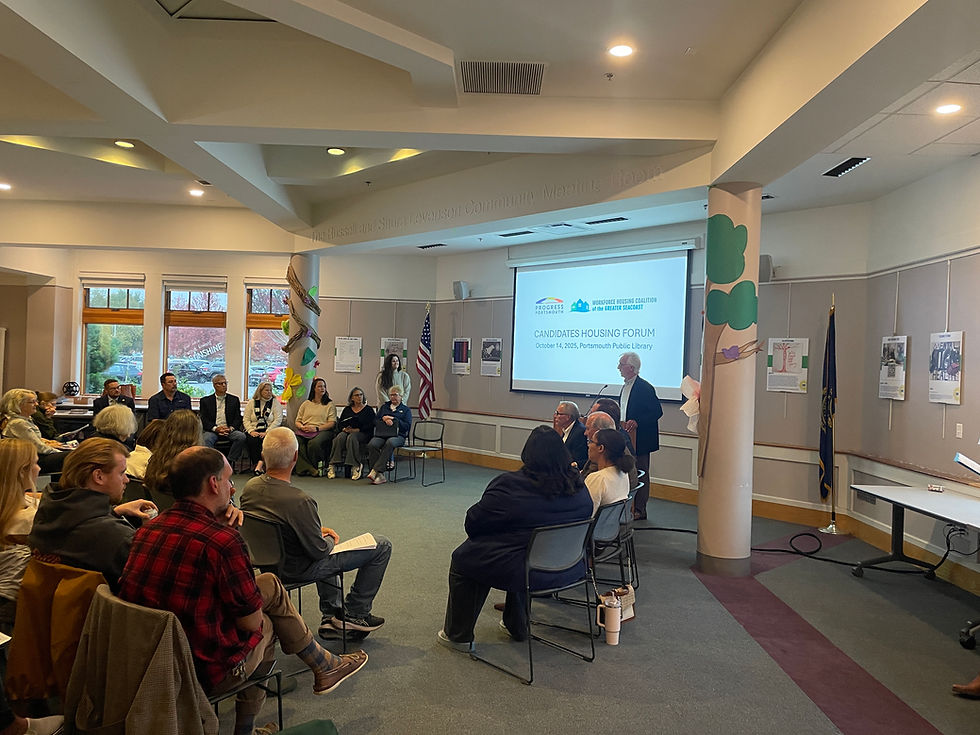Event Recap: Approaches for Communities Without Public Water and Sewer Infrastructure
- Seacoast WHC
- Jul 27, 2023
- 4 min read
Updated: Aug 11
On June 15th, the Workforce Housing Coalition hosted a community discussion on housing approaches for municipalities with limited or no public water and sewer infrastructure. With New Hampshire facing a housing shortage of almost 60,000 units by the end of the decade and rising costs pushing housing out of reach for many, it’s clear more housing is needed all across the state. It’s needed in our cities, our suburban communities, and our rural communities.
But, one size fits all solutions will not work.
There are real differences in the approaches that communities without public water and sewer infrastructure can take to address the housing shortages in their communities. Over the years, the default approach in many rural communities and rural zoning districts has been to restrict density to 2+ acre minimums for a single-family home and rationalize that policy decision with the argument that there’s nothing they can do without public wastewater infrastructure.
That’s not true and it’s an oversimplification of the infrastructure challenge. It’s a policy choice that will increase sprawl, reduce conservation land, and do little to impact our affordability challenges.
What is true is that this is a difficult challenge with no easy answers, but it’s possible. Here are some recommendations to consider and resources that came out of our community discussion.
Approaches to Consider
Soil-Based Standards and NH Department of Environmental Services (DES): Many communities set arbitrary minimum lot sizes using the rationale that the size is needed to support a septic system. The reality is that septic capacity is based on soil quality, not specific acreage. Communities that utilize soil-based standards are ensuring that their lot size is rooted in science, rather than arbitrary limits.
Wastewater systems are ultimately regulated by the New Hampshire Department of Environmental Services with minimum soil-based standards that require state approval before receiving a permit. Many communities have instituted more restrictive standards than the Department of Environmental Services requires. If your community has instituted more restrictive ordinances than DES requires, then you are making a policy decision to require larger lots than are necessary for the safe dispersal of wastewater.
Recommendation: Utilize soil-based standards and default to Department of Environmental Services standards. The Department of Environmental Services Land Resources Management Division is there to help.
Connect to Regional Infrastructure: There will always be limits to housing density and economic development in communities without any public water or sewer infrastructure. If a neighboring community has wastewater infrastructure and existing capacity, then you should explore opportunities to connect to the existing infrastructure. New water and sewer infrastructure is expensive, and with tight municipal budgets, the financial resources may not be available. If the opportunity to connect to an adjacent municipality’s infrastructure exists, then it can be a win-win. The host community receives additional revenue to help offset infrastructure costs and the connecting municipality spurs economic development.
Recommendation: Assess opportunities for regional connections or new public infrastructure.
Community Septic Systems (Private) and Cluster Development: Community septic systems and other shared options can help lower costs by spreading maintenance, construction, and land costs out over more households. Cluster development – often referred to as conservation subdivision or open space subdivision – allows developers to take a large lot and locate homes in smaller clusters while leaving more land for available open space. This reduces infrastructure costs (for the entire project) and land costs (for each unit), which can lead to more affordable options.
In areas without public wastewater infrastructure, community septic systems are often utilized in cluster developments. The combination of cluster development and a community septic system increases density and can lower costs while maintaining significant open space. You can read more about cluster ordinances as part of the New Hampshire Housing Toolbox.
Recommendation: Review municipal cluster development ordinance and evaluate any barriers to community septic systems. If your cluster ordinance is not being utilized, why not?
Community or Decentralized Septic Systems (Public) and Innovative Land Use: New Hampshire state law contains a number of innovative land use tools that communities can institute to incentivize development including Tax Increment Financing (TIF) Districts and the 79-E Community Revitalization Tax Relief program. These innovative tools can be combined with the construction of a public community or decentralized wastewater system that allows a district within a community to connect to public wastewater infrastructure. This approach could be used to revitalize a downtown or environmentally sensitive area.
This investment by a municipality can unlock new opportunities to build a more vibrant community and increase the tax base. Municipal community systems also serve as a more affordable option than building an entire municipal treatment plant. The capacity for a community or decentralized system is significantly lower than a municipal treatment plant, but in a smaller community with a smaller targeted area for growth, the capacity challenges may be less of a barrier.
The town of Newbury, NH took the approach of building a municipal decentralized wastewater system to maintain a community around Lake Sunapee. The New Hampshire Housing Toolbox includes Newbury in its wastewater system alternatives case studies.
Overall, these are tough challenges, but there is a real opportunity. There is a clear need for more housing in our state and every community is impacted. All communities need teachers, police officers, firefighters, and employees for local businesses. If your community does not have public water or sewer infrastructure, review these recommendations, explore what might work with your community’s vision, and don’t hesitate to reach out with questions!
Resources:





Comments